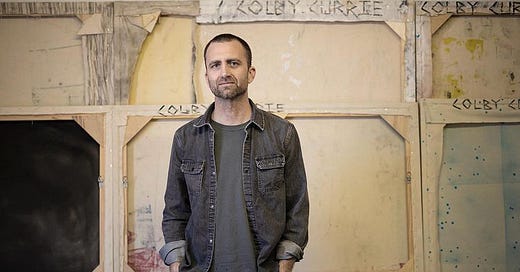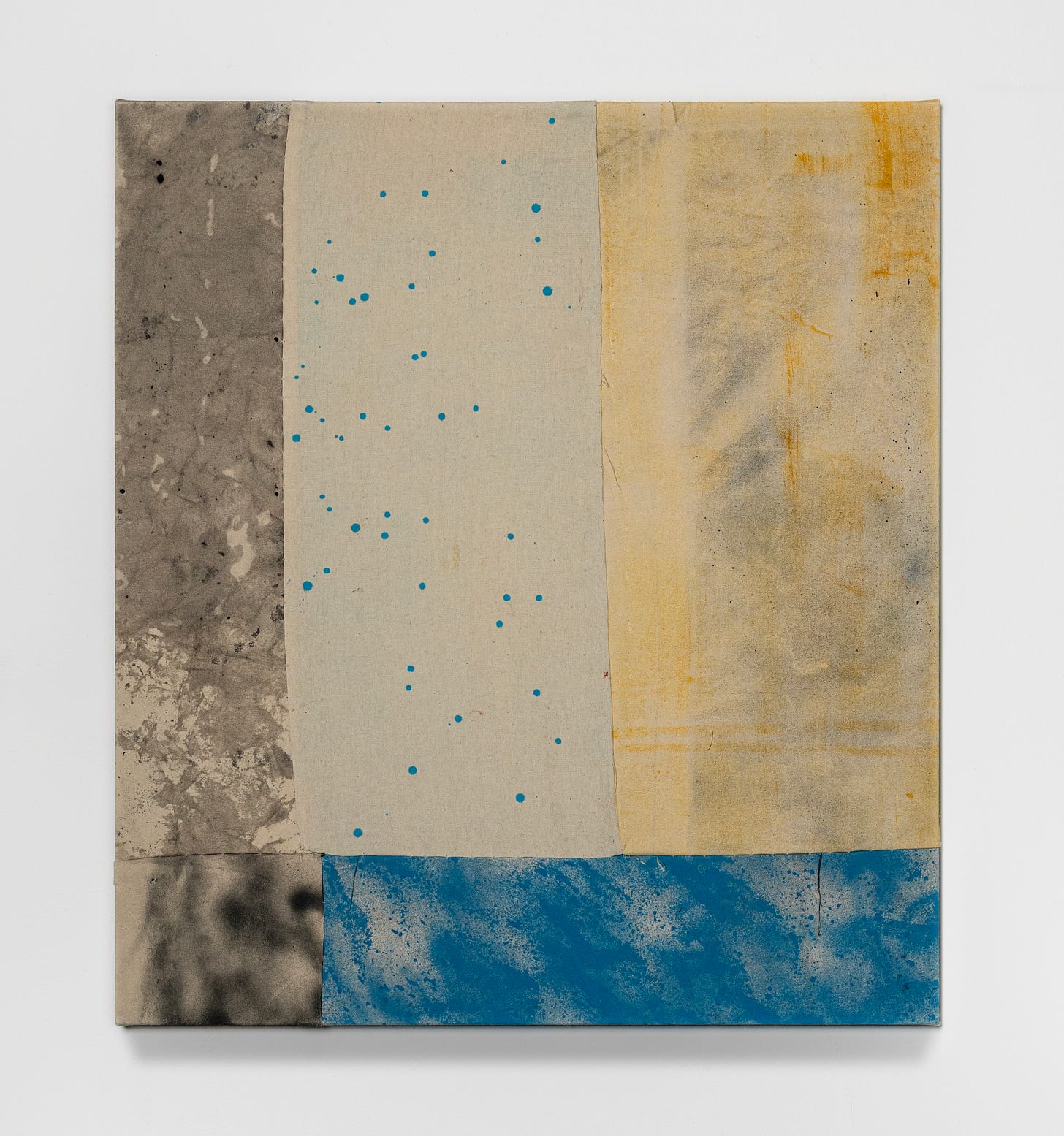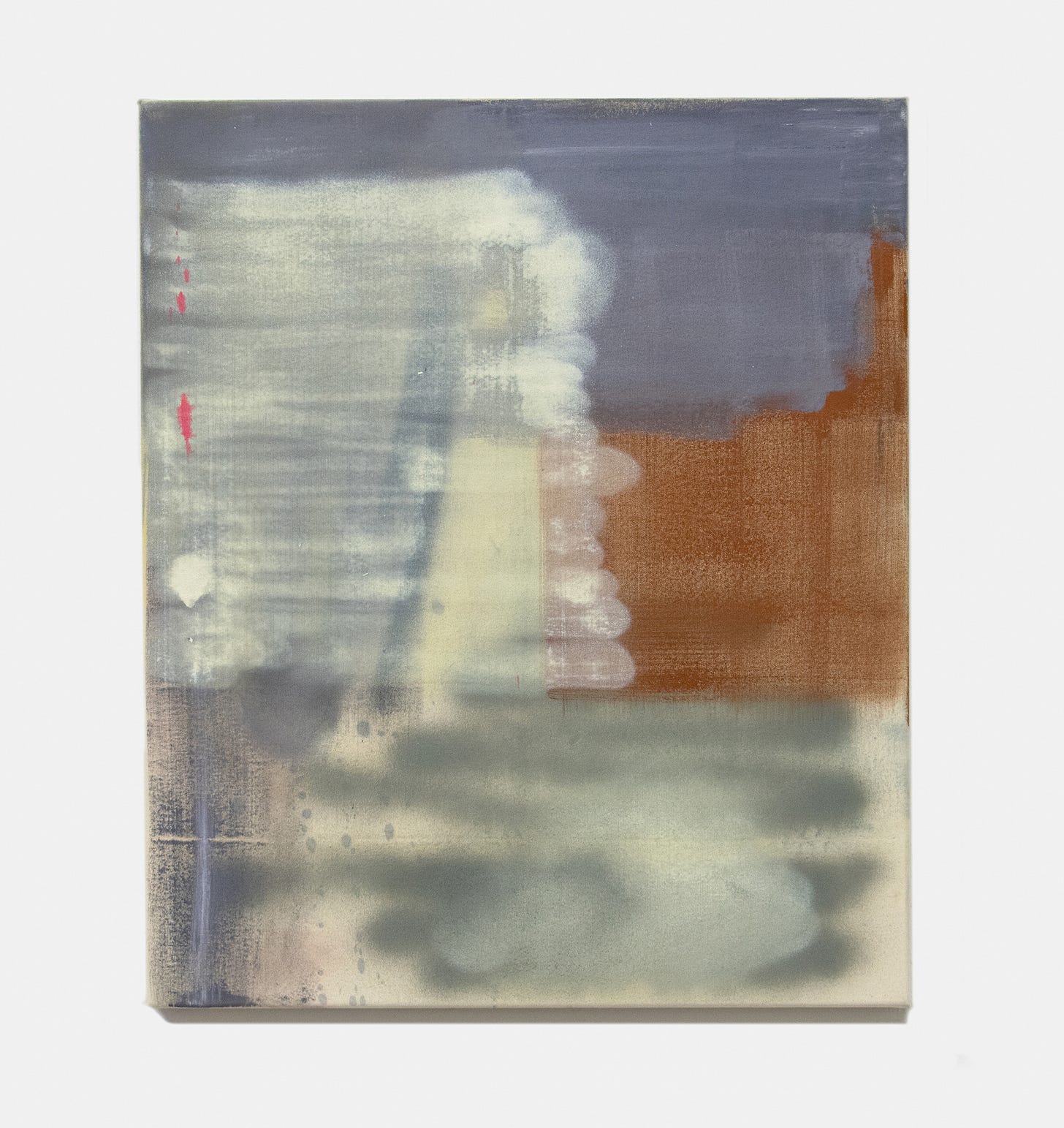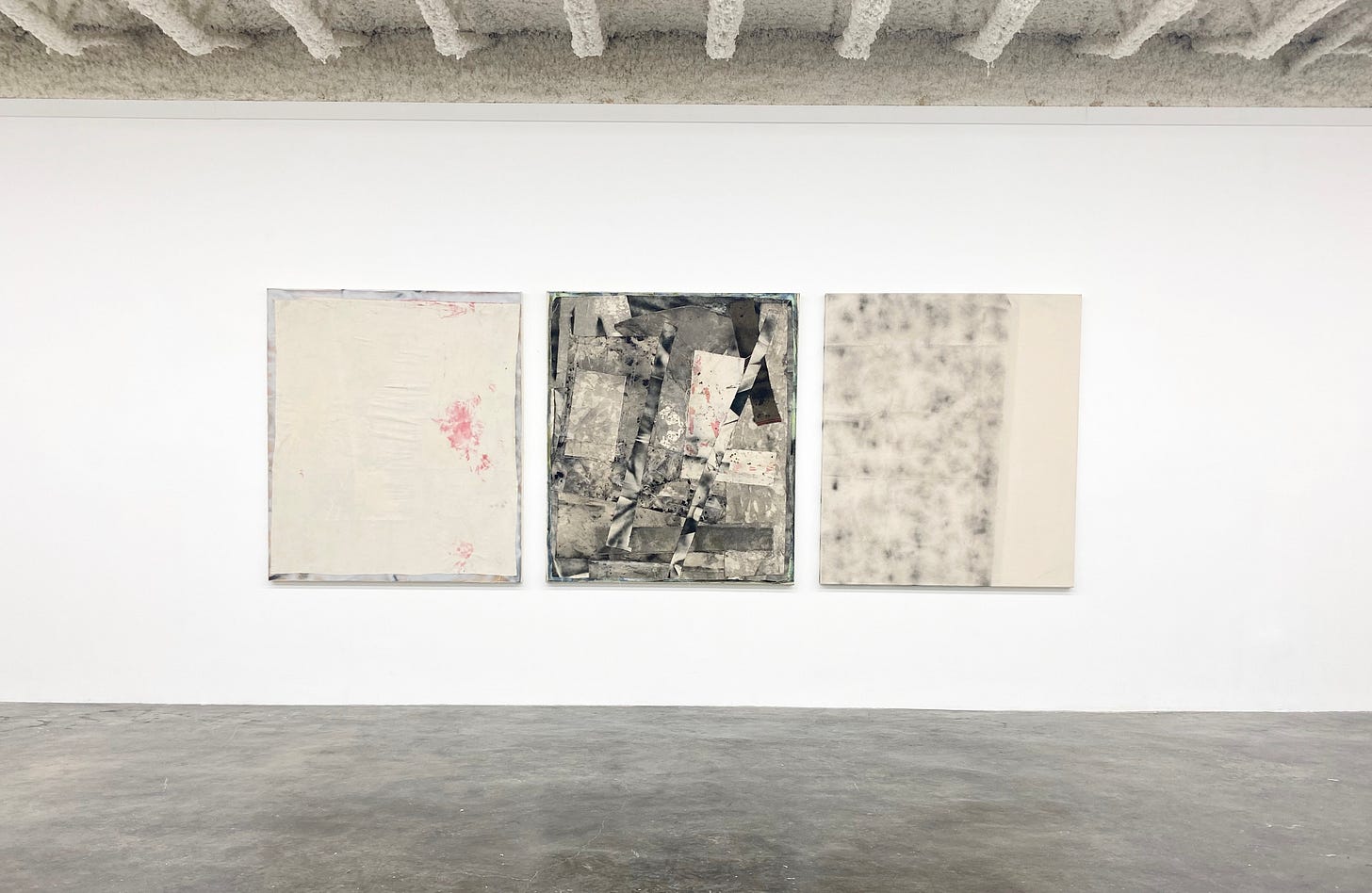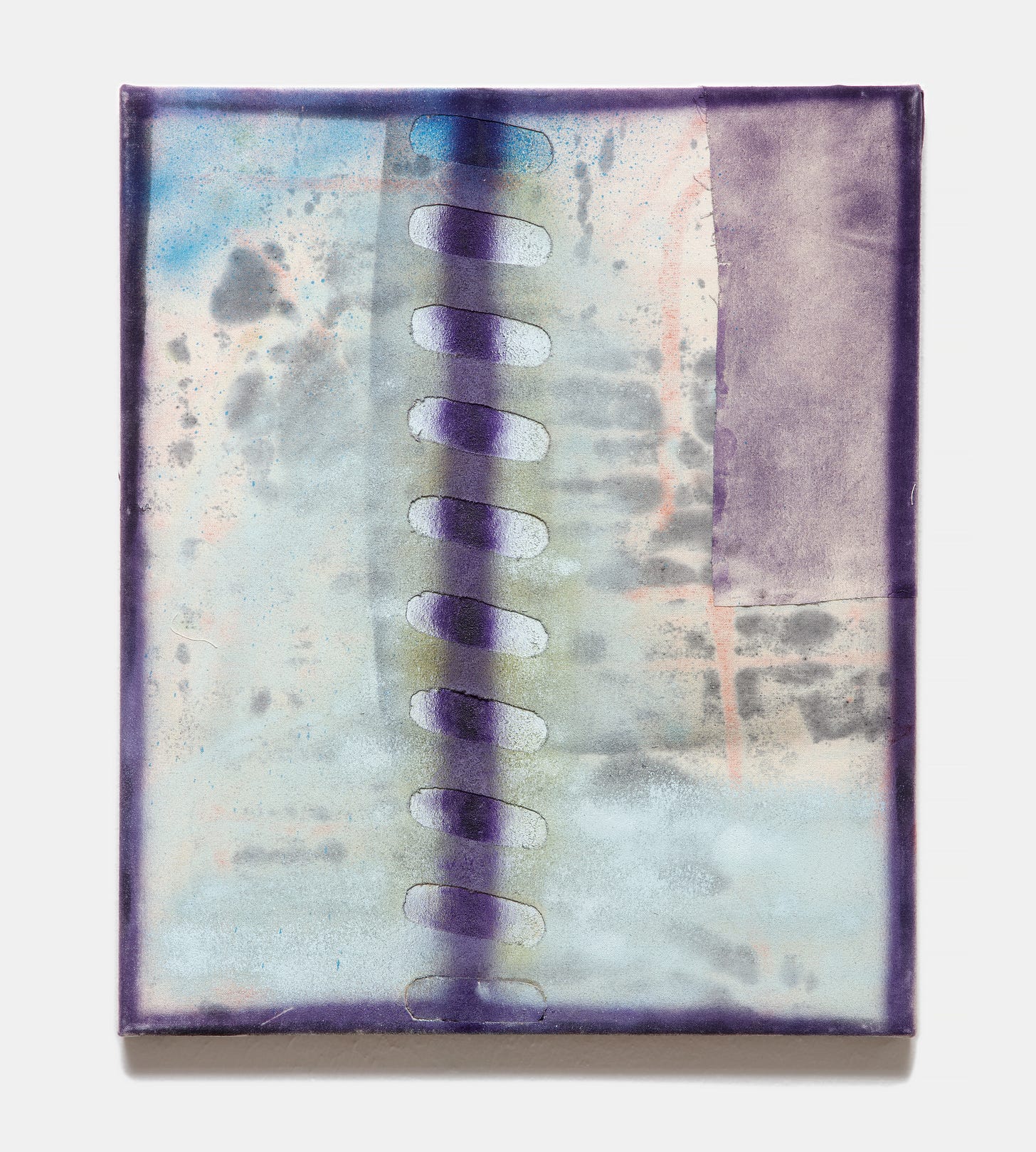Colby Currie’s Paintings are Sewn Together from Studio Scraps
Part of the reason for starting this newsletter was so we could speak to artists whose practices overlapped with our own. One such artist whose work I related to was Colby Currie.
I first saw his works on Instagram and appreciated them as minimalist paintings. I especially loved how he used the colour of the raw canvas. Then I used my fingers to zoom in a bit. I saw he had sewn different fragments together, pulling various offcuts into one carefully considered composition. It felt as if he had constructed a painting.
In my own work I’ve played with collage, specifically working with scraps from abandoned works. There’s something compelling about taking what was unwanted, what was unintended, and then making that the work. I’m also drawn to artists who use non-traditional methods and think outside of their medium. On the one hand, I think of Colby’s works as paintings, but on the other, I think of them as collages. They break rules, and in doing so they carry a sense of playfulness that’s palpable.
I reached out to Colby, who’s based in Texas, to see how he arrived at his unique way of making paintings.
Hi Colby. I love the way you often let raw canvas play a role in your colour palette. How do you think about those choices?
I’m influenced mostly by my surroundings. I grew up in Amarillo, Texas (literally Spanish for yellow), which is known for its flat plains, big skies, and dead grass; which is where I think it gets its name. I recently moved back after living in Dallas for 10 years. I’ve absorbed experiences from both places and they seem to fuse together in my own language.
Dallas is colourful and gritty, full of graffiti buffs and random visual occurrences that could spark an idea for a painting. Whereas Amarillo has its limitations because it’s more remote. People here have to do more with less. I like the “work smarter, not harder” methodology that growing up here has taught me.
I had a professor in grad school, Ed Blackburn, who was coincidentally from Amarillo too. He said something that stuck with me about old films. He explained how directors had to work on a tight budget so they would come up with clever hacks to utilize the whiteness of the screen. I think about that and how raw canvas affects what you put on it if you don’t prime it, both in terms of negative space and light.
I was wondering how you build up a piece. Do you use a lot of scraps and offcuts from old paintings?
I like to work on multiple canvases that are the same size and approach each piece differently. There are days when I’m experimenting with ways to treat the canvas with various marks and patinas. On those days I lay out extra sections of canvas to collect random studio debris that can lead somewhere for future paintings. There are also days for cleaning and organising that are productive for beginning to assemble new pieces from my ever-growing collection of scraps. The scraps definitely include old paintings (both whole and in parts). Even if I’ve had to scrap a painting, some part of it will end up being a vital component of something else.
Are you sewing materials together on a canvas? How are they attached?
Basically the ways that I can physically work the canvas are sewing, gluing, and stapling. Early on, my goal was to make paintings that had disparate parts that work together like a collage yet without collaged elements. It’s still a good goal, but the means to get there for me is to forget about it and make collaged paintings. Then when an idyllic painting sprouts up, I’ll recognise it. Allowing that kind of variety has been freeing and has led to some fun experiments in collage.
A process I like to do variations of is gluing scraps of canvas onto the back of a painting. Then after it dries, I’ll cut the front of the painting off, revealing the patchwork of canvas on the backside. There’s a bit more to it and involves un-stretching and re-stretching the canvas while the glue dries. It can be an awkward wrestling of materials. That’s one example of how paintings get assembled. At the moment I’m working on a couple of large textile pieces that are entirely hand sewn and do not have stretcher bars. Basically quilts, but still very much paintings.
There are so many different textures and marks in your work, and half of my enjoyment is wondering how you made them. Can you shed any light on your process?
Everything starts with the intention to try something I’ve been thinking about. I’ll start an experiment to see where it goes, then I usually have to loosen my understanding of what my intentions are and things start to happen. I try to mimic the random order that goes on out in the world, in my studio.
I enjoy being physical and direct with my work yet at the same time I want my marks to look like they were made by nature. It’s an odd balance I’m looking for, of making things that are handmade but from a distance. For example, I’d prefer to puncture a can of spray paint and run around the studio aiming at pieces of canvas rather than swirling something out with lines on a surface in front of me.
I sense a playfulness in your work, even in the more stripped back pieces, which is refreshing given that a lot of minimal abstract painting can present itself in a very austere way. Is that something you’re conscious of?
When I’m painting I’m loosened up and having a good time, so I’m glad that comes through. Working in series of the same size helps because paintings can riff off each other in logical and unexpected ways.
Do you look at work by other painters? Modern or old, who gets you excited?
I look at a lot of work but not as much as I did when I was in school. I’m glad you asked even though it’s hard to pinpoint one or two. For contemporary, I love the ethereal quality and color of John Zurier’s work and the materiality and playfulness of Rose Wylie. I don’t approach my work like either of them but I resonate with the spatial qualities of both painters. They have a light airiness about them that I hope comes through in my work too. From the past, I’ll go with the Impressionists. I resonate with the whole idea of emotionally interpreting the landscape and the way they dashed across the canvas.
What do you do when you’re not making art?
I go to my amazing full-time job in Museum Education and I stay on top of my self-care routine by running, cooking and listening to music.
Follow Colby on Instagram: @colbycurrie_studio
Visit Colby’s website: colbycurrie.com
Things on Our Radar This Week
Albert Oehlen’s new paintings at Gagosian, Grosvenor Hill, London (opens today!)
James Kalm’s video walk through of the amazing Raymond Saunders show at David Zwirner and Andrew Krepps in NYC (runs until 30 March)
The TRA Collective open call for artists for an exhibition in Whitechapel (deadline 14 April)
The legendary and definitive doc on the New York School Painters (1972) featuring Rauschenberg, de Kooning, Jasper Johns, Helen Frankenthaler and more.
Yto Barrada’s multidisciplinary works at Pace (opens 22 March)
Thanks for reading, see you next week!
Oliver & Kezia x


